Annual Festivals & Events
Update:2024/10/1
- Ebisu Festival
- Otondo (Great Bonfire)
- KIX Senshu International Marathon
- Hina Dolls for Hinamatsuri
- Sakai City Marathon
- Children’s Day Decorations
- Tour of Japan
- Sakai Grand Evening Fish Market
- Manto-e Buddhist Lantern Festival
- Tsukimi (Moon Viewing) Festival
- Danjiri Festivals
- Ko-odori Dance Festival
- Sakai Citizens' Olympics
- Sakai Festival
- Sakai Agricultural Festival
- Yassaihossai
January
Ebisu Festival
Date: 9-11 January
Place: Sugawara Shrine (2-1-38 Ebisuno-cho Higashi, Sakai-ku)
Access: 10 minutes from Sakai station (Nankai Line) or Sakaihigashi station (Nankai Koya Line). Also 3 minutes from Oshoji station (Hankai Tramway).
This is a festival to celebrate “Ebe-ssan” (Ebisu), the Japanese god of fishermen and business prosperity. People visit to buy a lucky bamboo branch and decorate it with lucky charms for prosperity and wellbeing, or a bamboo rake decorated with auspicious motifs to “rake in” the good luck and fortune for the next year. These are especially popular amongst business owners and you can see them placed inside shop/restaurant walls.
Otondo (Great Bonfire)
Date: Last Sunday of January
Time: 10:00-16:00
Place: Ebaraji Temple (1-8-20 Ebaraji-cho, Nishi-ku)
Access: Tsukuno station (JR Hanwa Line) or Monjumae bus stop (Nankai Bus)
Otondo is a fire festival where a huge bonfire is lit and its flames reaching as high as 5m. Shimekazari (New Year’s decorations), old good luck charms and talismans and other items on which New Year’s wishes and resolutions were made are burned in prayer for good health for the New Year. Ebaraji Temple is well known for being built on the birthplace of the great priest Gyoki.
February
KIX Senshu International Marathon

The Senshu area comprised of 9 cities and 4 towns in southern Osaka is promoting the KIX Senshu International Marathon as one of the major sporting events in Japan with over 5,000 runners from across the country and overseas.
This event was first held in commemoration with the opening of Kansai International Airport in 1994.
The full marathon starts in Hamadera Park, enters Sakai and then goes to Rinku Park in Izumisano City.
Official website: http://www.senshu-marathon.jp/
March
Hina Dolls for Hinamatsuri
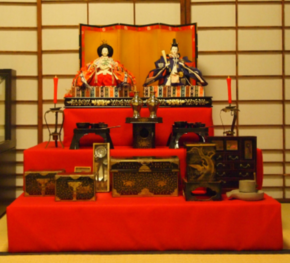
Date: March to April
Time: 10:00-17:00 (last entry at 16:30)
Closed: Every Tuesday
Cost: 100 yen (Seigakuin) 200 yen (Yamaguchi Residence) 250 yen for both
*free for junior high school and younger, Sakai residents 65 years of age and older, and those with disabilities
Access:
● Seigakuin – 5 minutes on foot from Takasu Jinsha station (Hankai Tramway) or Shichido station (Nankai Line)
● Yamaguchi Residence - 3 minutes on foot from Ayanocho station (Hankai Tramway)
No car parking is available so please use public transport.
The old part of the town where Seigakuin and the Yamaguchi Residence contains a number of old town houses which survived the war and date back as far as the Edo period (17th-19th century). Such houses will also be displaying hina dolls for everyone to see, particularly on weekends. Please confirm opening hours beforehand as they vary depending on facilities.
April
Sakai City Marathon
Runners can explore history, culture, and natural beauty as they trace a route through Nintoku-tenno-ryo Kofun (World Heritage Site) and Daisen Park. With a variety of courses ranging from a family marathon (2.5 kilometers) to a 10-kilometer race, there's an event that's right for everyone.
Date: April 29
Place: In and around Daisen Park
May
Children’s Day Decorations
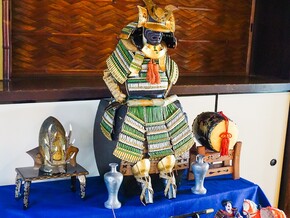
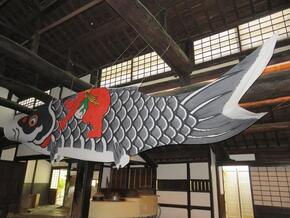
Date: April to May
Closed: Every Tuesday (Open on 3 May)
Time: 10:00-17:00 (last entrance 16:30)
Cost: 100 yen (Seigakuin) 200 yen (Yamaguchi Residence) 250 yen for both
*free for junior high school and younger, Sakai residents 65 years of age and older, and those with disabilities
Access:
・Seigakuin: 5 minutes walk from Takasu Jinsha station (Hankai Tramway) or Shichido station (Nankai Line)
・Yamaguchi Residence: 3 minutes walk from Ayanocho station (Hankai Tramway)
No car parking is available so please use public transport.
Seigakuin and the Yamaguchi Residence will display samurai armors that have been handed down for generations. The Yamaguchi Residence will also be decorated by a big carp streamer that is hand-painted by a craft master designated by Osaka Prefecture, and hold a carp streamer workshop on 29 April at 10:30 and 13:00. Reservations open from 10:00 4 April (6 people in one session, 1000 yen + admission). First come first serve basis, please call or fax the Yamaguchi Residence. TEL & FAX: 072-224-1155
Tour of Japan - Osaka Stage
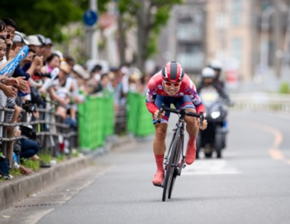
The Tour of Japan has developed itself into one of the most competitive international race in Asian region, involving participation of UCI professional teams and world’s best riders. Needless to say, it is the only stage race event held across the country, and bigger in scale compared to most of the sports event in Japan. Nearly 360,000 spectators visit the venue and watch the race on the road throughout the stages. The first of six stages starts in Sakai!
Official website: https://www.toj.co.jp/
July
Sakai Grand Evening Fish Market
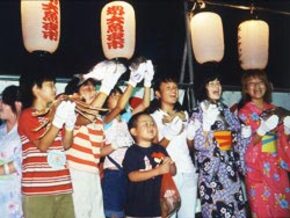
Believed to have begun during the Kamakura period and have an impressive history of about 700 years, this event is a seasonal summer tradition of Sakai. It first began when local fishermen made offerings of fish during Sumiyoshi Festival’s Mikoshi Togyo parade, and a fish market started being held on Ohama beach. The most exciting attraction is the fish auction that starts from around 19:00, and there are a lot of stalls at booths to ramble and shop around.
Date: 31 July
Place: Ohama Park
Time: 13:00-21:30
Nearest Station: Sakai station (Nankai Line)
August
Manto-e Buddhist Lantern Festival

Date: 15 August
Place: Hounji Temple (192 Imai, Mihara-ku)
Access: Catch the Nankai bus from Hatsushiba station (Nankai Koya Line) to Imai-minami bus stop
Manto-e is a traditional Buddhist rite where people light lanterns for the spirits of the dead and also pray for good health. The Manto-e Buddhist lantern festival at Hounji Temple started in 1825 but stopped indefinitely until about 100 years passed before it restarted.
The candles of the Manto-e calm and cleanse the hearts of all those who look upon them and are thus known as “healing lights”. On the night of Obon (15 August) as many as a thousand lanterns glow with the wishes and hopes of those who lit them, creating an enchanting atmosphere in the grounds of Hounji Temple.
September
Futon Daiko Festivals
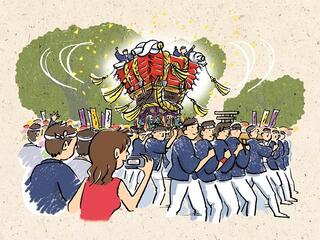
The most famous traditional festivals in Sakai are the futon daiko and danjiri festivals. You will see large portable shrines being shouldered and paraded around at futon daiko festival. At danjiri festivals you will see giant floats with exquisite wood carving barreling down the streets pulled by many people.
Aguchi Shrine (tbc)
Sugawara Shrine (tbc)
Funamachi Shrine (tbc)
Hochigai Shrine (tbc)
Kahyo Shrine (tbc)
Iwatsuta Shrine (tbc)
Mozu Hachimangu Shrine, Ishizu Shrine, Yasaka Shrine (Noto-cho), Yasaka Shrine (Nakamura-cho) (tbc)
Tsukimi (Moon Viewing) Festival
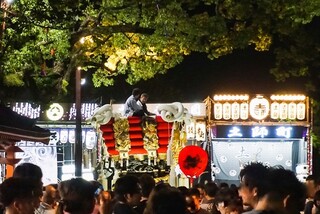
Date: Nearest weekend to August 15 on the lunar calendar
Place: Mozuhachimangu Shrine (5-706 Mozuakahata-cho, Sakai-ku)
Access: Mozu station (JR Hanwa Line) or Mozuhachiman station (Nankai Koya Line)
Of all the futon daiko festivals in southern Osaka, Mozuhachimangu Shrine holds one of the most well-known. The record says it has a long history of more than 300 years and came to be from prayers for good harvest, combined with the customs of celebrating the full moon. About four meters high and weighing roughly three tons, futon daiko consists of a platform with a taiko drum, on top of which are five overlapping layers of vermillion cushions. About 70 people carry the futon daiko, with their unique shouts of "bera-bera-bera-sho-shoi" mixing with the sound of the drum as they proceed through towns. Afterward, the drum is dedicated to the shrine. During this magnificent and dynamic festival, 17 futon daiko floats of all sizes move in and out of the shrine over the course of two days.
October
Danjiri Festivals
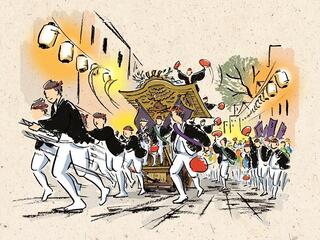
Along with the futon daiko festival, the danjiri festival is typical of the Sakai region's autumn festivals. Rolling danjiri carts are pulled through the streets in a lively festival overflowing with energy and vigor that is famously unique to the Senshu area. In Sakai, individual neighborhoods maintain over 80 danjiri carts and take great pride in the festival's rich historical traditions. In October of each year, the festival begins at Otori Shrine and continues at the autumn festivals of numerous shrines.
Kusabe Shrine, Otori Grand Shrine, Tsukuno Hachiman Shrine (tbc)
Ishizu Shrine, Hishiki Shrine, Nonomiya Shrine, Yasaka Shrine (Minamihanada-cho), Hirokuni Shrine, Tampi Shrine, Sugo Shrine, Hagiwara Shrine, Tajihayahime Shrine, Sakurai Shrine, Mitami Shrine (tbc)
Suearata Shrine, Atago Shrine (tbc)
Hachita Shrine (tbc)
Ko-odori Dance Festival
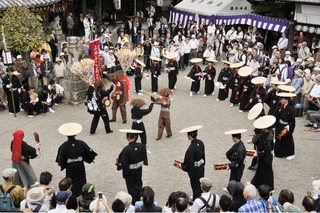
Date: First Sunday of October
Place: Sakurai Shrine
The Ko-odori dance festival is said to have originated as a rain-making prayer dance. Today the festival has been designated as an intangible Folk-Cultural Asset. The humorous dance, performed by 17 dancers dressed as demons and long-nosed tengu goblins, has been passed down from generation to generation since the Kamakura period. The dance is first presented at the site of the Kuni Shrine, then it heads toward Sakurai Shrine. The procession of dancers singing religious songs looks like as if it were in the fairytale world.
Sakai Citizens' Olympics
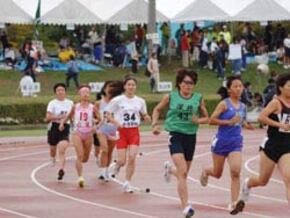
Sakai's comprehensive sports event, the Sakai Citizens' Olympics has been held every year since 1975 on Health and Sports Day (a national holiday that falls on the second Monday of October). Spirited competitions are held in the six events of softball, volleyball, table tennis, track and field, gate ball, and tug of war, with elementary school students from the city's various school districts joining participants of all ages, including senior citizens, who have won in local qualifying tournaments. Citizens from different neighborhoods mingle at event venues as they enjoy autumn, the season of sport.
Sakai Festival
The Sakai Festival has been held on the third Saturday and Sunday of October every year since 1974 as a way for residents to show their pride in their city. Central to the festival is a massive street festival, divided into several zones, such as stage parformance, martket, gourmet and family. Typically attracting more than 400,000 attendees, the event captures Sakai's uniquely historic and international flavor. Besides, traditional Futondaiko float procesion is a great spectacle and graceful tea ceremony serivice reflects the city's pride in the culture of the way of tea, which was perfected by Sakai-born great tea master Sen-no-Rikyu.
November
Sakai Agricultural Festival
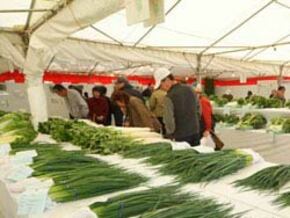
The Sakai City Agricultural Festival features the "Tore-tore Market" where visitors can purchase locally grown fresh fruits and vegetables; agricultural-livestock prize show; a flower market; a local specialties market; and stage performances. The Festival has been held on November 23 every year since 1976. It is designed to allow citizens to share the joy of autumn harvest with farmers and to promote better understanding and awareness of agriculture as well as to encourage the city's agricultural sector.
December
Yassaihossai

Date: 14 December
Place: Iwatsuta Shrine
Access: Ishizugawa station (Nankai Line) or Ishizu station (Hankai Tramway)
The words “Yassai Hossai” originate from the Japanese for “108”, from a legend in which Ebisu (the god of prosperity in business) washed ashore at Ishizu-no-Hama beach and local fishermen lit a fire of 108 bundles of firewood to warm him. The cinders are said to ward off evil spirits if taken home afterwards.
